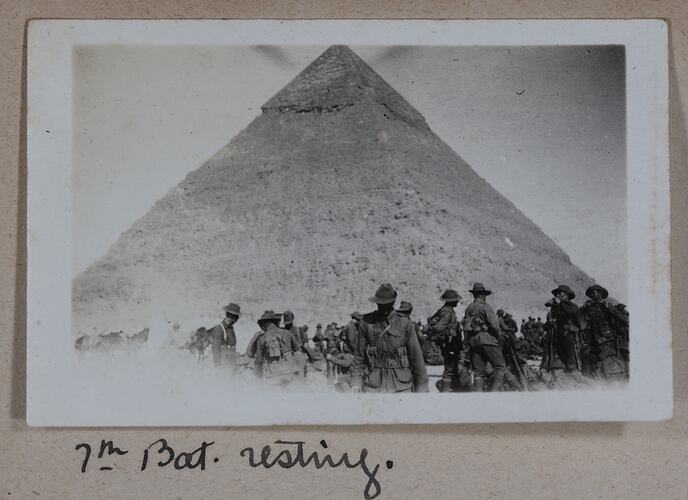Australia officially entered World War I in August 1914 when Prime Minister Andrew Fisher pledged Australia's full support to Britain's war effort. The Australian Infantry Force (AIF) duly left Australia about three months later, in November 1914. Originally bound for England, the convoy was redirected to Egypt, due to a perceived lack of space on the Salisbury Plain and British concerns over the security of the Suez Canal following Turkey's entry into the war.
Australian troops arrived in Egypt in early December 1914 and were stationed to three main training camps around Cairo. The largest of these camps was that at Mena, near the pyramids of Giza, which had its own railway line into Cairo and was the site of the Egyptian Army's manoeuvre grounds.
After the troops had arrived in Egypt they were placed under the command of British General Sir W. Birdwood, and organised to form the Australian and New Zealand Army Corps. This was later shortened to the code name 'ANZAC' and passed into common use following the Gallipoli landing.
The main focus of the Australian's time in Egypt was training and the area around Mena Camp was divided into three training grounds, one for each infantry brigade. The light horse artillery and engineers were allotted sections of desert further out from the camp whilst the ambulance and transport corps trained near the camp. The troops were trained intensively in smaller units known as battalions before being trained as a brigade and, later, as a division. Training lasted for at least eight hours a day and the troops were issued limited leave to Cairo in their off hours. However, as Charles Bean noted, the Australian troops were not 'regular soldiers' and in their off hours they were prone to seek entertainment in Cairo, whether useful or not.
This often expressed itself in the celebrated larrikinism of the Australian troops, particularly the younger recruits, which was most often displayed when visiting Cairo. Although this was usually confined to relatively minor insubordination - such as general rowdiness and a disregard for English officers - there was also an underlying racism amongst the troops that led to tensions with the local population (sometimes referred to as 'niggers' and 'gyppos'). The most famous example of the mounting tensions between the Australians and the Egyptians is 'The Battle of Wassa' (also known as Wasa'a or Wozzer).
Although usually regarded as a single incident, there were in fact two 'battles', one that took place on 2 April 1915 and a second on 31 July 1915. It is difficult to ascertain the reasons behind these skirmishes; however the most well-known are revenge for venereal diseases contracted by some of the troops or a rescue attempt for the sister of an Englishman who had fallen victim to the white slave trade (or a combination of both). In any case, the general consensus is that most of the men present were onlookers rather than participants. Another, more serious, battle that the Australian troops participated in was against the Turks in defence of the Suez Canal in early February 1915. However, the battle was largely a British undertaking with only two Australian battalions present who appear to have played a supportive rather than an active role in the battle.
For the most part, however, the troops spent their time training or taking in the sites in Cairo and its surrounds, particularly the nearby pyramids.
The AIF eventually left Egypt for the Gallipoli peninsula and then the Western Front. The Australian presence in Egypt remained throughout the war in the context of hospitals and smaller troop camps. The Australians appear to have completely withdrawn only at the end of the war.
During World War II, troops of the Second Australian Infantry Force were also stationed in Egypt.
Museums Victoria's collection includes thousands of objects relating to the relatively short amount of time that the Australian troops were stationed in Egypt. Of particular interest is the diary kept by Sapper Alfred Galbraith (who has a further 102 items associated with his service) along with those of Corporal S.W. Siddeley, Sister Lily Mackenzie, Private Jack Chugg and 2nd Corporal Alan Homer, who were also stationed in Egypt. Another important Egypt-related collection contains the photograph albums of Captain Edward Albert McKenna that deal exclusively with his experiences in Egypt (particularly Mena Camp), one of which includes a photograph of the H.M.A.S. Sydney following her defeat of the S.M.S. Emden en route to Egypt in 1914. Also of note within the Museum's collection are the photograph albums of Private (later Sergeant) John Lord, one of which contains an image of the aftermath of 'The Battle of Wassa,' and various postcard albums, several of which are significant due to the inclusion of lost practices or sites within Egypt.
References
Charles Bean, Chapter VII: 'Training in the Desert,' Volume I, Official History of Australia in the War of 1914-1918, at: http://www.awm.gov.au/collection/records/awmohww1/aif/vol1/awmohww1-aif-vol1-ch7.pdf, accessed: October 17, 2012
Peter Dennis, Jeffery Grey, Ewan Morris, Robin Prior with Jean Bou (Eds.) and Graham Wilson, 'Egypt, Australians in,' The Oxford Companion to Australian Military History, Second Edition, Oxford University Press (Australia and New Zealand: 2008), pp. 194-5
'Chapter 3: Egypt,' in Greg Kerr, Lost Anzacs: The Story of Two Brothers, Oxford University Press (Melbourne, Oxford, Auckland, New York: 1997), pp. 35-64
'Australian Military History,' Wikipedia, at: http://en.wikipedia.org/wiki/Military_history_of_Australia_during_World_War_I, accessed: August 24, 2012
Smythe Family Website (http://www.smythe.id.au/index.htm)
'World War I Diary of Percy Smythe,' transcribed by Betty Smythe, at: http://www.smythe.id.au/diary/index.htm, accessed: August 24, 2012
'World War I Letters Home,' at: http://www.smythe.id.au/letters/index.htm, accessed: August 24, 2012
Australian Military History of the Early 20th Century: Desert Column ()
'First Wassa, Egypt, April 2, 1915, John "Jack" Jensen's Account,' at: http://alh-research.tripod.com/Light_Horse/index.blog/1973775/first-wassa-egypt-april-2-1915-john-jack-jensens-account/ accessed: August 24, 2012
'Cairo Camps,' at: http://alh-research.tripod.com/Light_Horse/index.blog?topic_id=1106105 accessed: August 24, 2012
More Information
-
Keywords
-
Localities
-
Authors
-
Article types
